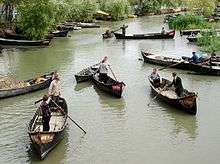Lipovans
Lipovans or Lippovans (Russian: Липовáне, Romanian: Lipoveni, Ukrainian: Липовани, Bulgarian: липованци) are Old Believers, mostly of Russian ethnic origin, who settled in Romania in the Moldavian Principality, and in the regions of Dobruja and Eastern Muntenia. According to the Romanian census of 2002, there are a total of 35,791 Lipovans in Romania, of whom 21,623 live in Dobruja.

Name
The name of the Lipovans is not known exactly , but it may come from the linden trees ("Lipa" or "Липа" in Russian) of the area they populate bordering the Wild Fields. However, one story claims the name derives from the name "Filipp" (1672-1742) which is alleged to have been the true name of the son of Nikita Pustosvyat (d.1683) who according to the same rather dubious legend led the group of dissenters who emigrated to what is now Romania, his adepts being named Filippovtsy which became Lipovtsi and finally Lippovane.[1] Another story derives it from "Filippovka", a holiday name dedicated to Saint Philip of Moscow.
History
The Lipovans emigrated from Russia in the 18th century, as dissenters from the main Russian Orthodox Church. They settled along the Prut River in Moldavia and in the Danube Delta. They have maintained strong religious traditions which predate the reforms of the Russian Orthodox Church undertaken during the rule of Patriarch Nikon. When the Patriarch made changes to worship in 1652, some believers carried on worshipping in the "old way". In that sense, they continued to speak Old Russian, to cross themselves with two fingers instead of three, and to keep their beards. The Russian government and the Orthodox Church persecuted them, and as a result some committed suicide by burning themselves (self-burning: soshigateli),[2] with many others being forced to emigrate.
In 1876, the Lipovans were joined by members of the Skoptsy sect, who also emigrated to Romania to escape persecution.
Lipovans were considered to be schismatic by the Russian Orthodox Church, although relations have improved recently. (See main article on Old Believers.)
Population


The main centre of Lipovan community in Ukraine is the town of Vylkove, which has its own church, St Nicholas. In order to construct their homes, the Lipovans create islets of dry land by digging mud out from trenches and making a series of canals. The house walls are made of reed and mud,[3][4] and thatching is standard for the roofing. Because of the characteristics of these materials, the buildings have a tendency to sink into the mud and need to be rebuilt every few years.
The population is popularly known as having red hair.[5]
For details on the Lipovans in Bulgaria, see Russians in Bulgaria.
References
- Victor Vascenco, "Melchisedec şi lipovenii" Archived 2009-08-24 at the Wayback Machine, Romanoslavica (University of Bucharest), XLII, p. 133
- Coleman, Loren (2004). The Copycat Effect: How the Media and Popular Culture Trigger the Mayhem in Tomorrow's Headlines. New York: Paraview Pocket-Simon and Schuster. p. 46. ISBN 0-7434-8223-9.
- "Water world". The Independent. London. 2005-06-18. Archived from the original on 2007-09-27. Retrieved 2010-05-07.
- "The Danube". Archived from the original on 2006-05-04.
- http://icc-online.arte-ct.ro/vol_01/10.pdf
External links
- Second-Hand Souls: Selected Writing by Nichita Danilov (translated from Romanian by Sean Cotter)
- Lipovan's icons: The Bleschunov Municipal Museum of Personal Collections
- Romania. Religious Freedom Report 1999
- Zorile newspaper published in Romanian and Russian